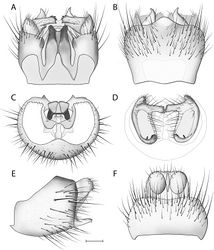Acomoptera digitata
| Notice: | This page is derived from the original publication listed below, whose author(s) should always be credited. Further contributors may edit and improve the content of this page and, consequently, need to be credited as well (see page history). Any assessment of factual correctness requires a careful review of the original article as well as of subsequent contributions.
If you are uncertain whether your planned contribution is correct or not, we suggest that you use the associated discussion page instead of editing the page directly. This page should be cited as follows (rationale):
Citation formats to copy and paste
BibTeX: @article{Kerr2011ZooKeys137, RIS/ Endnote: TY - JOUR Wikipedia/ Citizendium: <ref name="Kerr2011ZooKeys137">{{Citation See also the citation download page at the journal. |
Ordo: Diptera
Familia: Mycetophilidae
Genus: Acomoptera
Name
Acomoptera digitata Kerr, 2011 sp. n. – Wikispecies link – ZooBank link – Pensoft Profile
Type Material
Holotype: ♂, “USA, Oregon, Curry Co., small seep (#2) on Elko road, 42°23.122'N, 124°13.736'W 925m, 2.vi.2009 G. Courtney CSCA09L472" / “HOLOTYPE 09D070 ♂ Acomoptera digitata Kerr 2011" [red label]. Deposited in CSCA, complete specimen in excellent condition, mounted on gray point.
Paratypes: 10 ♂♂, 1♀ “USA: CA: Del Norte Co, SixRiversNF, ForRoute16N02, nr. BearBasin Outlk, 41.8016°N, 123.7369°W, 1500masl, 3.vi-24.vii.2009 P.H.Kerr & O.Lonsdale, 6m MT, CSCA09L526" [CSCA].
Diagnosis
This species may be distinguished from all other Acomoptera species by the dorsoventrally elongate suboval shape of the gonostylus, which features a prominent, finger-like lobe that projects inward (Fig. 11D) and a ventral, posterior-protruding lip that bears an elongate, narrow process (Figs 11D–E).
Description
Male. Body length (n=6): 5.2–6.4 mm (avg = 5.9 mm). Wing length: 5.0–6.1 mm (avg = 5.6 mm).
Coloration (Figs 6A, 7). Head brown; palpomeres light brown. Antennal scape light brown, pedicel and flagellomeres yellow to yellowish brown. Thorax variously brown to cream-colored, in parts; pair of darker brown markings on scutum laterad of dorsocentral setae, scutum setae gold- or golden brown-colored; antepronotum, proepisternum, and proepimeron dark brown, anepisternum, katepisternum, and meron brown; anepimeron cream-colored and noticeably lighter in color than surrounding sclerites; laterotergite brown; metanepisternum and metakatepisternum brown to dark brown; mediotergite brown centrally, cream-colored laterally. Legs becoming increasingly brown towards tarsi, coxae cream-colored (coxal setae yellow); femur yellowish or cream-colored, tibia yellowish brown, tarsi light brown. Wing hyaline without markings, wing veins light brown; haltere stem and knob cream-colored to yellowish brown. Abdominal segments concolorous, brown, with golden brown setae. Terminalia yellowish brown to brown.
Head. Ocelli slightly raised; middle ocellus smaller or about the same size as lateral ocelli; lateral ocellus located approx. its own width (approx. width of two eye facets) from eye margin, separated from median ocellus by 2–3× its own diameter. Eyes with sparse, inconspicuous microsetae, which are approximately as long as width of facet. Face with brown setae, longest of which approx. same length as width of face. Antennal length approx. 0.75× length of abdomen. Palpus shorter than width of head (anterior view); palpomere 2 clearly shorter than palpomere 3; palpomere 4 approx. 3× longer than wide; palpomere 5 approx. 6× longer than wide, shorter than combined length of palpomeres 3 and 4.
Thorax (Fig. 7). Antepronotum bearing setae; remaining thoracic sclerites bare. Tarsal claw usually with two small ventral teeth. Wing venation as in Fig. 8; costal vein extends beyond R5, approx. 0.25× distance between R5 and M1; R1, R5, and M1 with at least some setae on lower surface.
Male Genitalia (Figs 10–11). Epandrium approx. 2× wider than long (Fig. 11F). Gonocoxites without developed dorsomedial comb (Figs 11A, 11C). Gonostylus complex, as shown in Figs 10, 11A–B, 11D–E.
Female. Body length (n=1): 5.9 mm; wing length (n=1): 5.6 mm.
As male in all aspects except the following:
Generally moderately darker than male (Fig. 6B). Antennal scape brown, pedicel and flagellomeres light brown, yellowish brown, or brown. Scutum setae black. Legs becoming increasingly brown towards tarsi, coxae light brown (coxal setae black); fore femur yellowish or cream-colored, mid and hind femora light brown or brown; tibia and tarsi brown to light brown. Wing membrane darker and wing veins stronger than in male; abdominal setae black. Terminalia yellowish or yellowish light brown, form as in Fig. 9.
Comment
The female specimen was united with males on the basis of similar coloration patterns (e.g., bicolored mediotergite) and having been collected with males at a locality known only for this species.
Etymology
The species epithet “digitata" is an adjective derived from the Latin word for finger, referring to the adaxial process of the gonostylus.
Original Description
- Kerr, P; 2011: Six new species of Acomoptera from North America (Diptera, Mycetophilidae) ZooKeys, 137: 41-76. doi
Images
|
![Figure 6. Acomoptera digitata sp. n., habitus, lateral view: A male [691271] B female [691264]. Scale line = 1 mm.](/w/media/thumb/e/e4/ZooKeys-137-041-g006.jpg/250px-ZooKeys-137-041-g006.jpg)
![Figure 7. Acomoptera digitata sp. n., thorax, lateral view [692363]. Scale line = 0.5 mm. Abbreviations: anepm anepimeron anepst anepisternum aprnt antepronotum a spr anterior spiracle cx coxa kepst katepisternum ltg laterotergite mr meron mtg mediotergite mtanepst metanepisternum mtepm metepimeron mtkepst metakatepisternum p spr posterior spiracle patg paratergite proepm proepimeron proepst proepisternum sc scutum sctl scutellum.](/w/media/thumb/d/d6/ZooKeys-137-041-g007.jpg/250px-ZooKeys-137-041-g007.jpg)
![' Figure 8.' Acomoptera digitata sp. n., wing, dorsal view [692360]. Scale line = 1 mm.](/w/media/thumb/1/19/ZooKeys-137-041-g008.jpg/250px-ZooKeys-137-041-g008.jpg)
![Figure 9. Acomoptera digitata sp. n., female genitalia: A lateral view [692365] B ventral view [692366]. Scale line = 0.1 mm. Abbreviations: c cercus st sternite t tergite.](/w/media/thumb/d/d1/ZooKeys-137-041-g009.jpg/156px-ZooKeys-137-041-g009.jpg)
![Figure 10. Acomoptera digitata sp. n., male genitalia, images: A dorsal view [692367] B ventral view [692368] C lateral view [692369] D posterior view [692370]. Scale line = 0.1 mm.](/w/media/thumb/3/33/ZooKeys-137-041-g010.jpg/250px-ZooKeys-137-041-g010.jpg)
